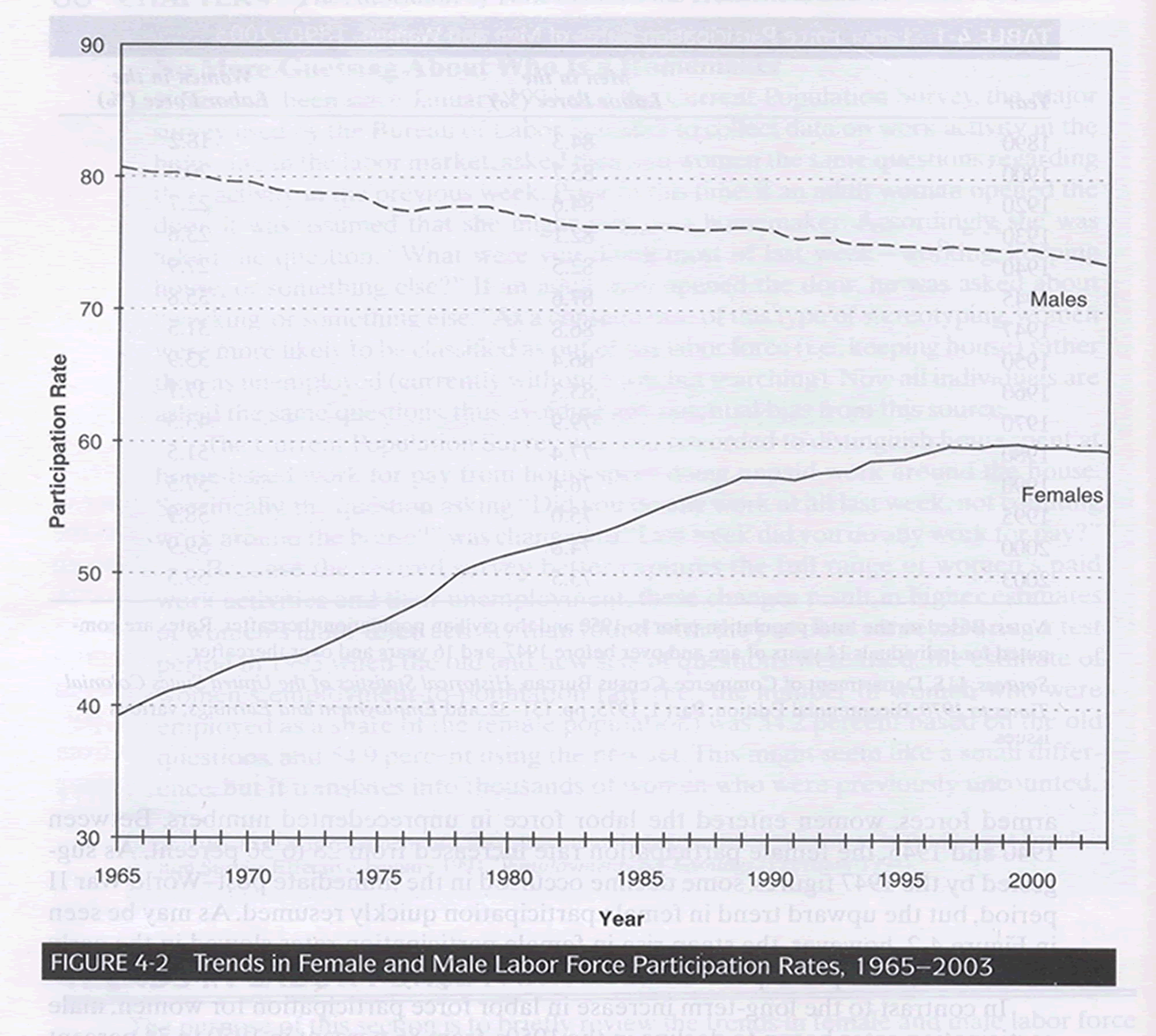Equal Rights and Opportunity in the Labor Force
- Entering the Workforce -
Main | Entering the Workforce | Careerism | Fighting Sexual Discrimination | Key Victories | Additional Resources | Glossary
 |
Traditional Sexual Division of Labor |
 |
Women's participation in the labor force has traditionally been defined and limited by a sexual division of labor. Men are expected to engage in wage-earning work while women are expected to participate in unpaid labor, which generally includes, among other things, child care, meal preparation, and household duties. Mainstream economist Gary Becker describes this sexual division of labor as a result of comparative advantage [1]. Comparative advantage refers to the specialization of men and women in either home production or market production. In the traditional heterosexual relationship, men and women can exchange their production in these two spheres in order to contribute to the overall productivity of the family. Traditional notions of marriage assume that women have a comparative advantage in the home while men have a comparative advantage in the labor force, and consequently translates to women being full-time homemakers. Though this does not mean that women are unable to be productive in the labor force or that men are unable to be productive in the home, it implies that certain genders are more productive in their respective assigned spheres than are their presumed heterosexual spouses.
Reasons for Comparative Advantage
Conservative Focus |
Feminist Focus |
|
|
According to societal expectations and norms, women were expected to permanently leave the paid labor force upon marriage. Prior to the 1940s, the typical female worker was young and single as it was acceptable for single women to pursue paid work in order to support themselves. Once married, women were expected to work in the home as full-time homemakers and to stop pursing wage-earning jobs. For a married woman to engage in paid wage work was viewed as neglectful of her family and household duties. Bans such as the "marriage bar," which was instituted in the late 1800s until the mid 1900s, prohibited the employment of married women. Around this time, only 14 percent of married women participated in the labor force while 46 percent of single women participated in the labor force [2].
 |
Married Women's Entrance into the Labor Force |
 |
With the onset of World War II, more women began to enter the labor force as men left their civilian jobs to join the armed forces. In 1960, just 37.7% of women were in the labor force. As shown in the graph below, by 1980, around the time that The Feminine Mystique was published, the women's labor force participation rate had increased steadily to 51.5%. By 2000, that percentage had increased to a high of 59.9%.[3]
 [4]
[4]
Though there was a drop in women's labor participation right after the war, an upward trend soon followed. Not only were more women entering the labor force in greater numbers, a higher percentage of married women were also entering the labor force. In 1960, only 31.9% of married women were participating in the labor force. By 1993, that number had risen to 59.4%.[5] The graph below illustrates this trend, showing that the percent of single women in the labor force remained relatively constant while the percent of married women increased significantly between decades. This was due in part to the entry of older women with school-aged or grown children into the labor force. Participation rates of married mothers increased mainly in the 1960s to the 1980s, compounded by a variety of factors including an increase in real wages, lower fertility rates, better economic conditions, and a growing need for more educated individuals in the market.
[6]
In addition to these changes in labor force participation, societal perceptions and attitudes towards women were also changing. Stemming from Betty Friedan's identification of "the problem that has no name," Equal Opportunity Feminism began to help married women challenge female exclusion from the labor force.
What were the words women used when they tried to express it? Sometimes a woman would say "I feel empty somehow . . . incomplete." Or she would say, "I feel as if I don't exist."
She is dissatisfied with a lot that women of other lands can only dream of. Her discontent is deep, pervasive, and impervious to the superficial remedies which are offered at every hand.... An army of professional explorers have already charted the major sources of trouble.... From the beginning of time, the female cycle has defined and confined woman's role. As Freud was credited with saying: "Anatomy is destiny."
Betty Friedan, The Feminine Mystique [7]
Feminist critiques of the traditional sexual division of labor helped to propel women into the labor market by recognizing the unfulfillment that women felt in being isolated as full-time homemakers and the dangers in forced dependence on men. Recognizing that it is highly unrealistic that women have a comparative advantage in all household tasks and that the full specialization by husbands in market work and the wife in housework may not maximize familial utility, women began to recognize the strong disadvantages of complete specialization.
- Specialization is unfulfilling & domestic productivity decreases over time
As women engage in full-time homemaking, they find themselves frustrated and isolated. Often times, women may have many skills and abilities, which they desire to utilize in the economy and work outside the home. Women also find that their decision to be a full-time homemaker was not a free choice, but rather a consequence of socialization and societal expectations. Because a women's productivity in the unpaid domestic sphere is based primarily in their roles as wives and mothers, a homemaker's contribution to the family (which is the greatest while children are young) decreases over time. As children grow up and leave the home, women have an "empty nest syndrome" and find themselves completely unengaged by their surroundings and without any particular role.
- Specialization is risky for women
In the event of divorce or the death of a spouse, women who have engaged solely in unpaid labor are left without any real source of income to sustain themselves and any children that they may have. A woman may become bankrupt and live in poverty with her children. Having been out of the labor force to engage in full-time homemaking, women have neither work experience nor strong marketable skills. Full-time homemakers are dependent on their working husbands, and don't have much control and security over an unknown future.
- Inequality in allocation of power and money
In addition to being very risky for women, the traditional sexual division of labor unfairly allocates money and power in a relationship. When a conflict of interests arises between a husband and wife, relative bargaining power plays a role in how these conflicts are resolved. Because men bring home income, they often hold more power in dictating household decisions. Women's lack of earnings prevent them from equal and strips them of options. Because a woman is at a greater disadvantage if a marriage breaks up, she feels greater pressure to subordinate her wishes to that of her husband. Women involved in domestic violence often find themselves "less likely to have the financial means to leave an abusive relationship or to effectively persuade their husband to stop the battering while still remaining in the marriage."[8] Women with no other options have no feasible “outs” to the relationship.
- Specialization can lead to inefficiency & lack of complementarity
With men completely specializing in the workplace and women in the home, there is no joint effort or sense of collective responsibilities within the marriage. Some tasks, such as raising the children, are done more efficiently when performed by the two individuals together rather than alone. Any sense of complementarity that could result when men work alongside women and contribute their skills and attributes to the home, are lost with full and separate specialization. Furthermore, though some women have a comparative advantage in home-making, many are not fully efficient working solely in the home. Their full productive skills are not efficiently put to use when limited only within the domestic realm. It is highly unrealistic a wife will have a comparative advantage in performing all household tasks as compared to the husband, and it is therefore more efficient for him participate in unpaid home work.
Because of these reasons, more women, particularly married women, entered the labor force. However, although more women were now involved in the paid labor force, they often were limited to lower paying, lower status occupations. Women were segregated into women's jobs, while men remained in traditionally masculine jobs. The second aspect that Equal Opportunity Feminism simultaneously worked against discrimination: Equal Opportunity Feminism - Equality in Careerism.
References
[1] Becker, Gary S. A Treatise on the Family. Harvard University Press, 2005.
[2] Blau, Francine D., Marianne A. Ferber, and Anne E. Winkler. The Economics of Women, Men, and Work. 5th ed. Upper Saddle Riber, NJ: Pearson Prentice Hall, 2006. 29.
[3] [4] Ibid., 90.
[5][6] "Free Markets, Free Choices:." Pacific Research Institute. 18 May 2007 <http://www.pacificresearch.org/pub/sab/social/gend-pay/index.html>.
[7] Friedan, Betty. The Feminine Mystique. Dell, 1964.
[8] Blau, Francine D., Marianne A. Ferber, and Anne E. Winkler. The Economics of Women, Men, and Work. 5th ed. Upper Saddle Riber, NJ: Pearson Prentice Hall, 2006. 47.
- Table of Contents -